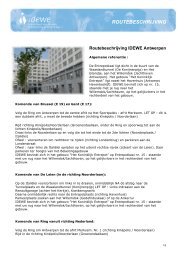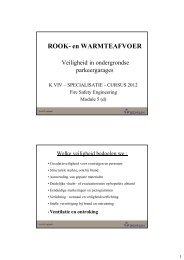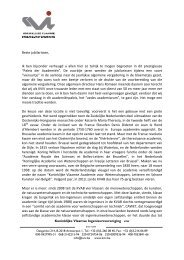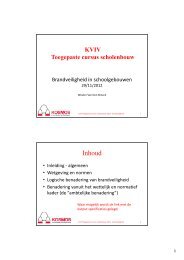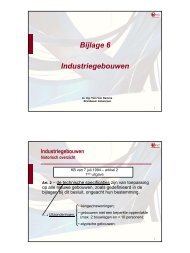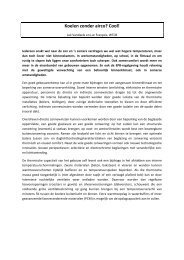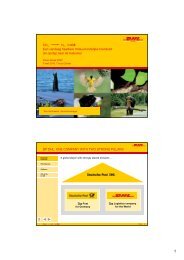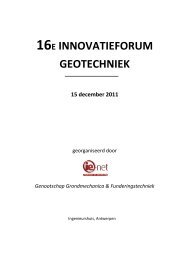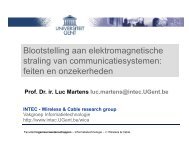Schoonbaert volledig - ie-net
Schoonbaert volledig - ie-net
Schoonbaert volledig - ie-net
Create successful ePaper yourself
Turn your PDF publications into a flip-book with our unique Google optimized e-Paper software.
An Updated International Survey ofComputer Models 91<br />
use of two uniform zones allows for reasonable approximations of the<br />
development of a fire in an enclosure under many conditions.<br />
Since the original survey [1], only a few new zone models (approximately<br />
20) have been identif<strong>ie</strong>d. While many of the models identif<strong>ie</strong>d in the original<br />
survey have been improved, the basic zonal approach has been stud<strong>ie</strong>d<br />
thoroughly and, therefore, the opportunit<strong>ie</strong>s to develop a novel zone model<br />
arelimited.<br />
Table 1 lists the zone models which have been identif<strong>ie</strong>d for the model<br />
survey.<br />
F<strong>ie</strong>ld Models<br />
F<strong>ie</strong>ld models, like zone models, are used to model fire development inside<br />
a compartment or a ser<strong>ie</strong>s of compartments. While a zone model divides the<br />
compartment into two zones, and solves the conservation equations (i.e.,<br />
mass, energy, and momentum) within these zones, a f<strong>ie</strong>ld model divides the<br />
compartment into a large number (on the order of thousands) of control<br />
volumes and solves the conservation equations inside each control volume.<br />
This allows for a more detailed solution compared to zone models. Because<br />
there are more than two uniform zones, a f<strong>ie</strong>ld model can be appropriate for<br />
more complex geometr<strong>ie</strong>s where two zones do not accurately describe the<br />
fire phenomenon. They can also be used for fires outside of compartments,<br />
such as large outdoor fuel tank fires [136].<br />
While f<strong>ie</strong>ld models provide very detailed solutions, they require detailed<br />
input information, and usually require more computing resources in order<br />
to model the fire. This can create a costly time delay in obtaining a solution<br />
whilezonemodels usually providea solution morequickly.<br />
In this study, nearly twice as many f<strong>ie</strong>ld models were identif<strong>ie</strong>d than that<br />
in the original survey. This trend of increasingly growing numbers of f<strong>ie</strong>ld<br />
models stems from improved computer hardware which allows for faster,<br />
more complex computational techniques.<br />
Table 2 lists the f<strong>ie</strong>ld models which have been identif<strong>ie</strong>d for the model<br />
survey.<br />
Detector Response Models<br />
Detector response models predict primarily the time to activation of an<br />
initiating device. While most of these models predict the response of a<br />
thermal detector, sprinkler, or fusible link to a fire-induced flow, a few<br />
calculate the response of a smoke detector.<br />
Typically, these models utilize the zonal approach to calculate smoke and<br />
heat transport, but utilize submodels to determine the response of the




